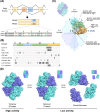Nuclear PKM2: a signal receiver, a gene programmer, and a metabolic modulator
- PMID: 40790192
- PMCID: PMC12341297
- DOI: 10.1186/s12929-025-01170-6
Nuclear PKM2: a signal receiver, a gene programmer, and a metabolic modulator
Abstract
Pyruvate kinase M2 (PKM2) is a key enzyme involved in glycolysis, yet its role in cancer extends far beyond metabolic flux. Unlike its isoform PKM1, PKM2 exhibits unique regulatory properties due to alternative splicing and dynamic structural plasticity, enabling it to translocate into the nucleus. Once nuclear, PKM2 functions as a signal receiver, gene programmer, and metabolic modulator by acting as a co-transcriptional activator and protein kinase. In this capacity, nPKM2 (nuclear PKM2) orchestrates the transcription of genes involved in glycolysis, lipogenesis, redox homeostasis, and cell cycle progression, thereby reinforcing the Warburg effect and promoting tumor growth, metastasis, and resistance to stress. In this regard, nPKM2 can be considered as the oncogenic component of PKM2. This review consolidates current knowledge on the structural basis of PKM2 assembly and the post-translational modifications that govern its oligomeric state and nuclear import. We also explore emerging therapeutic strategies aimed at targeting nPKM2, including small-molecule modulators that stabilize its cytosolic tetrameric form or disrupt its nuclear functions. Ultimately, the multifaceted roles of nuclear PKM2 underscore its significance as a critical oncoprotein and a promising target for precision cancer therapy.
Keywords: Cancer metabolism; Gene programmer; Metabolic modulator; Nuclear PKM2; Nuclear translocation; Oncogenic signaling; Post-translational modification; Signal receiver.
© 2025. The Author(s).
Conflict of interest statement
Declarations. Ethics approval and consent to participate: Not applicable. Consent for publication: Not applicable. Competing interests: The authors declare no competing interests.
Figures




References
-
- Anastasiou D, Poulogiannis G, Asara JM, Boxer MB, Jiang JK, Shen M, Bellinger G, Sasaki AT, Locasale JW, Auld DS, Thomas CJ, Vander Heiden MG, Cantley LC. Inhibition of pyruvate kinase M2 by reactive oxygen species contributes to cellular antioxidant responses. Science. 2011;334(6060):1278–83. - PMC - PubMed
-
- Anastasiou D, Yu Y, Israelsen WJ, Jiang JK, Boxer MB, Hong BS, Tempel W, Dimov S, Shen M, Jha A, Yang H, Mattaini KR, Metallo CM, Fiske BP, Courtney KD, Malstrom S, Khan TM, Kung C, Skoumbourdis AP, Veith H, Southall N, Walsh MJ, Brimacombe KR, Leister W, Lunt SY, Johnson ZR, Yen KE, Kunii K, Davidson SM, Christofk HR, Austin CP, Inglese J, Harris MH, Asara JM, Stephanopoulos G, Salituro FG, Jin S, Dang L, Auld DS, Park HW, Cantley LC, Thomas CJ, Vander Heiden MG. Pyruvate kinase M2 activators promote tetramer formation and suppress tumorigenesis. Nat Chem Biol. 2012;8(10):839–47. - PMC - PubMed
-
- Anitha M, Kaur G, Baquer NZ, Bamezai R. Dominant negative effect of novel mutations in pyruvate kinase-M2. DNA Cell Biol. 2004;23(7):442–9. - PubMed
Publication types
MeSH terms
Substances
LinkOut - more resources
Full Text Sources
Medical
Miscellaneous

